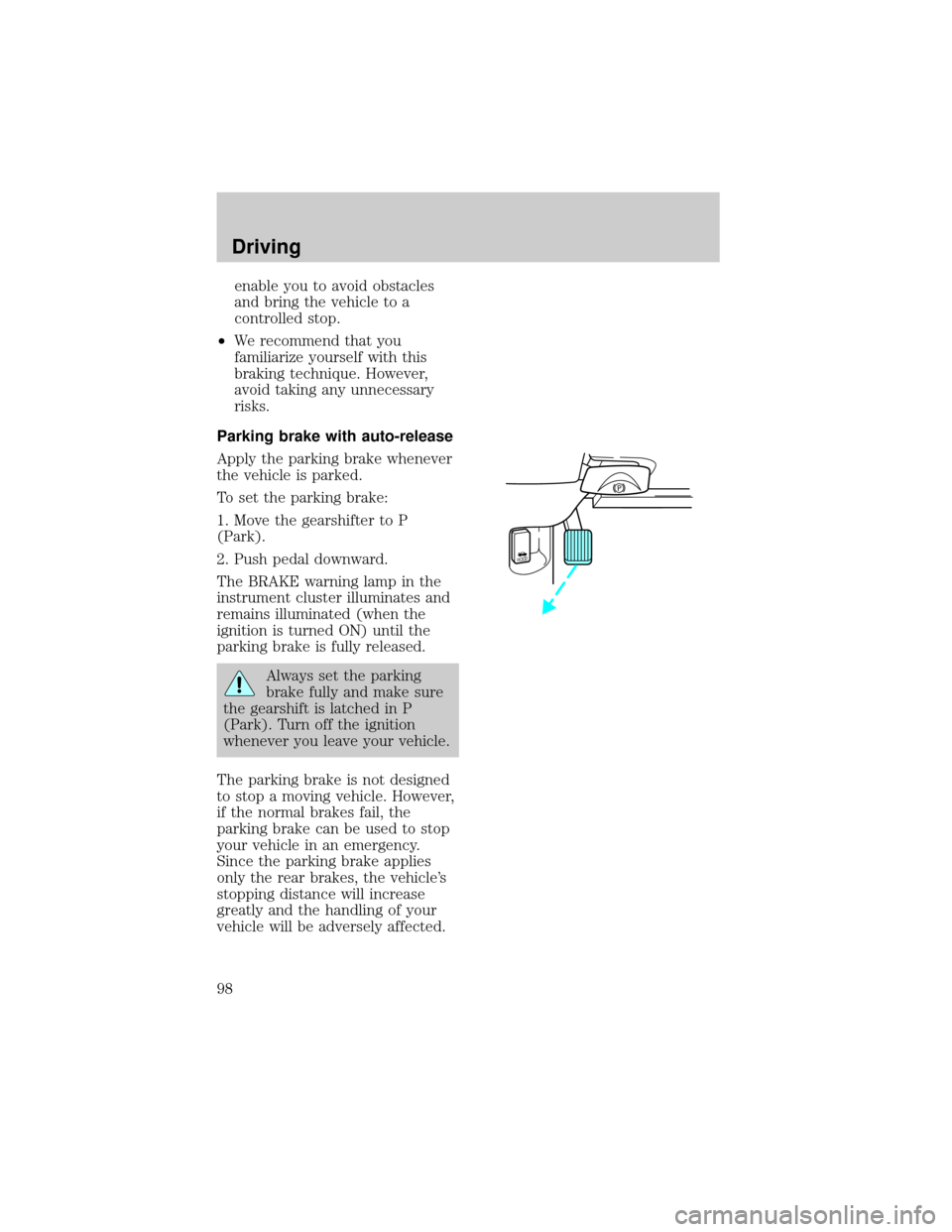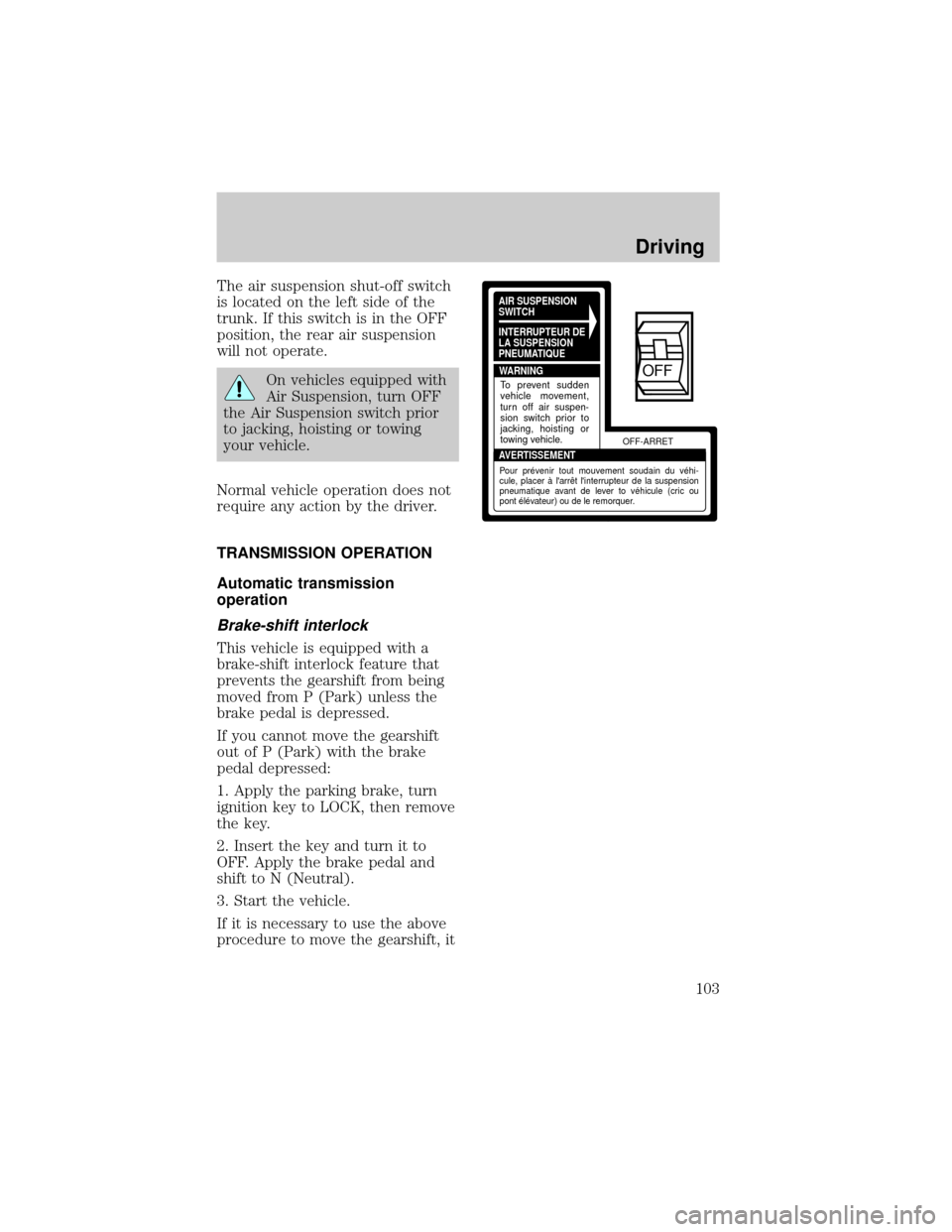Page 89 of 188
PREPARING TO START YOUR
VEHICLE
Engine starting is controlled by the
ignition system. This system meets
all Canadian Interference-Causing
Equipment standard requirements
regulating the impulse electrical
field strength of radio noise.
When starting a fuel-injected
engine, avoid pressing the
accelerator before or during
starting. Only use the accelerator
when you have difficulty starting
the engine. For more information
on starting the vehicle, refer to
Starting the enginein this
chapter.
Extended idling at high
engine speeds can produce
very high temperatures in the
engine and exhaust system,
creating the risk of fire or other
damage.
Do not park, idle, or drive
your vehicle in dry grass
or other dry ground cover. The
emission system heats up the
engine compartment and exhaust
system, which can start a fire.
Starting
90
Page 97 of 188

enable you to avoid obstacles
and bring the vehicle to a
controlled stop.
²We recommend that you
familiarize yourself with this
braking technique. However,
avoid taking any unnecessary
risks.
Parking brake with auto-release
Apply the parking brake whenever
the vehicle is parked.
To set the parking brake:
1. Move the gearshifter to P
(Park).
2. Push pedal downward.
The BRAKE warning lamp in the
instrument cluster illuminates and
remains illuminated (when the
ignition is turned ON) until the
parking brake is fully released.
Always set the parking
brake fully and make sure
the gearshift is latched in P
(Park). Turn off the ignition
whenever you leave your vehicle.
The parking brake is not designed
to stop a moving vehicle. However,
if the normal brakes fail, the
parking brake can be used to stop
your vehicle in an emergency.
Since the parking brake applies
only the rear brakes, the vehicle's
stopping distance will increase
greatly and the handling of your
vehicle will be adversely affected.
HOOD
Driving
98
Page 98 of 188

Your vehicle has an automatic
parking brake release. To release
the parking brake:
1. Turn the ignition to the RUN
position.
2. Press the brake pedal.
3. Move the gearshifter from the P
(Park) position to one of the
forward gears (the parking brake
will not release automatically when
you shift into reverse). The brake
pedal must remain pressed while
the gearshifter is moved.
If the parking brake fails to release
after completing this procedure,
use the manual parking brake
release lever.
Pull the lever to manually release
the parking brake.
TRACTION CONTROLY
(IF EQUIPPED)
Your vehicle may be equipped with
the optional Traction Controly
system. This system helps maintain
the stability and steerability of
your vehicle. It is especially useful
on slippery and/or hilly road
surfaces. The system operates by
detecting and controlling wheel
spin. The system borrows many of
the electronic and mechanical
elements already present in the
anti-lock braking system (ABS).
HOOD
Driving
99
Page 100 of 188

portion of the system will shut
down to prevent the rear brakes
from overheating. A limited
Traction Controlyfunction using
only engine torque reduction will
still control wheels from
over-spinning. When the rear
brakes have cooled down, the
system will again function
normally. Anti-lock braking is not
affected by this condition and will
function normally during the cool
down period.
If the engine coolant temperature
is below þ23ÉC (þ10ÉF) the engine
torque reduction portion of the
Traction Controlysystem isNOT
active. The system will operate
normally when the engine coolant
warms up.
Traction control switch
The traction control switch is
located on the left side of the
glove compartment. The traction
control system defaults to ON
when the ignition key is turned
from OFF to RUN.
The traction control must be
turned off if you are using a
mini-spare tire in a rear wheel
position.
STEERING
Your vehicle is equipped with
power steering. Power steering
uses energy from the engine to
help steer the vehicle.
Never hold the steering wheel to
the extreme right or the extreme
Driving
101
Page 102 of 188

The air suspension shut-off switch
is located on the left side of the
trunk. If this switch is in the OFF
position, the rear air suspension
will not operate.
On vehicles equipped with
Air Suspension, turn OFF
the Air Suspension switch prior
to jacking, hoisting or towing
your vehicle.
Normal vehicle operation does not
require any action by the driver.
TRANSMISSION OPERATION
Automatic transmission
operation
Brake-shift interlock
This vehicle is equipped with a
brake-shift interlock feature that
prevents the gearshift from being
moved from P (Park) unless the
brake pedal is depressed.
If you cannot move the gearshift
out of P (Park) with the brake
pedal depressed:
1. Apply the parking brake, turn
ignition key to LOCK, then remove
the key.
2. Insert the key and turn it to
OFF. Apply the brake pedal and
shift to N (Neutral).
3. Start the vehicle.
If it is necessary to use the above
procedure to move the gearshift, it
AIR SUSPENSION
SWITCH
INTERRUPTEUR DE
LA SUSPENSION
PNEUMATIQUE
WARNING
AVERTISSEMENTOFF-ARRET
To prevent sudden
vehicle movement,
turn off air suspen-
sion switch prior to
jacking, hoisting or
towing vehicle.
Pour prévenir tout mouvement soudain du véhi-
cule, placer à l'arrêt l'interrupteur de la suspension
pneumatique avant de lever to véhicule (cric ou
pont élévateur) ou de le remorquer.
OFF
Driving
103
Page 103 of 188
is possible that a fuse has blown
and the vehicle's brakelamps may
not be operating properly. Refer to
Fuses and relaysin theRoadside
emergencieschapter.
Do not drive your vehicle
until you verify that the
brakelamps are working.
If your vehicle gets stuck in mud
or snow it may be rocked out by
shifting from forward and reverse
gears in a steady pattern. Press
lightly on the accelerator in each
gear.
Do not rock the vehicle for
more than a few minutes. The
transmission and tires may be
damaged or the engine may
overheat.
Always set the parking
brake fully and make sure
the gearshift is latched in P
(Park). Turn off the ignition
whenever you leave your vehicle.
Driving with a 4±speed
automatic transmission
Understanding gearshift
positions
Pull the gearshift lever towards
you and downward to move the
automatic gearshift.
Driving
104
Page 111 of 188

must park on a grade, place
wheel chocks under the trailer's
wheels.
Launching or retrieving a boat
When backing down a ramp during
boat launching or retrieval,
²Do not allow the static water
level to rise above the bottom
edge of the rear bumper and
²Do not allow waves to break
higher than 15 cm (six inches)
above the bottom edge of the
rear bumper.
Exceeding these limits may allow
water to enter critical vehicle
components, adversely affecting
driveability, emissions and
reliability.
If the rear axle is submerged in
water, the rear axle lubricant
should be checked and changed, if
necessary. The rear axle is filled
with a synthetic lubricant and does
not normally require a lubricant
change for the life of the vehicle.
Rear axle lubricant quantities
should not need to be checked
unless a leak is suspected.
DRIVING THROUGH WATER
Do not drive quickly through
standing water, especially if the
depth is unknown. Traction or
brake capability may be limited
and if the ignition system gets wet,
your engine may stall. Water may
also enter your engine's air intake
and severely damage your engine.
Driving
112
Page 113 of 188
HAZARD FLASHER
Use only in an emergency to warn
traffic of vehicle breakdown,
approaching danger, etc. The
hazard flashers can be operated
when the ignition is off.
²Slide the hazard flasher control
to the right to activate the
hazard flashers simultaneously.
²Slide the control to the left to
turn the flashers off.
FUEL PUMP SHUT-OFF SWITCH
If the engine cranks but does not
start after a collision, the fuel
pump shut-off switch may have
been activated. The shut-off switch
is a device intended to stop the
electric fuel pump when your
vehicle has been involved in a
substantial jolt.
1. Turn the ignition switch to the
OFF position.
2. Check the fuel system for leaks.
3. If no fuel leak is apparent, reset
the fuel pump shut-off switch by
pushing in the button on the
switch.
4. Turn the ignition switch to the
ON position. Pause for a few
seconds and return the key to the
OFF position.
5. Make a further check for leaks
in the fuel system.
Roadside emergencies
114